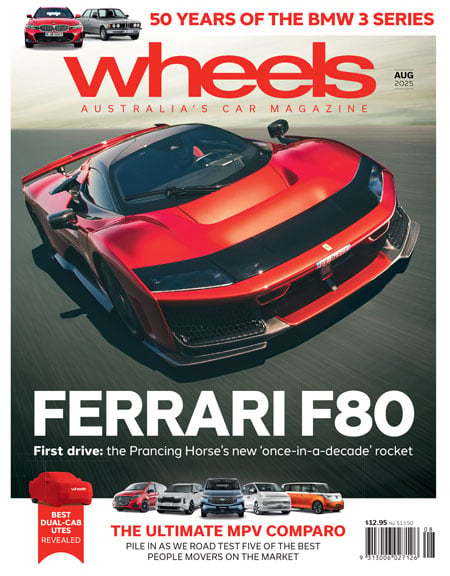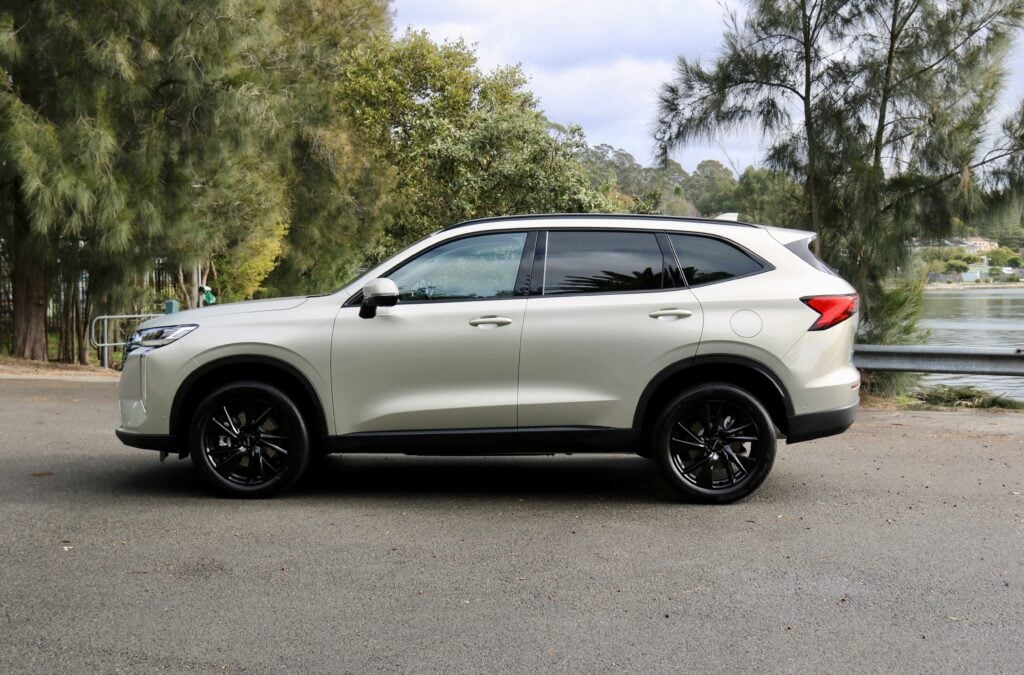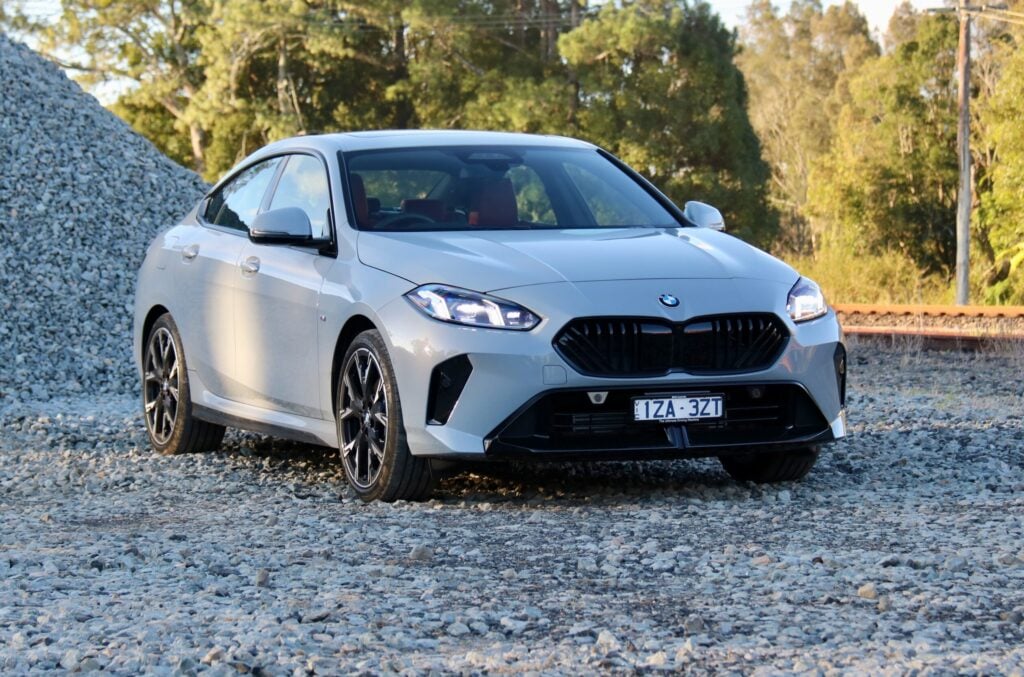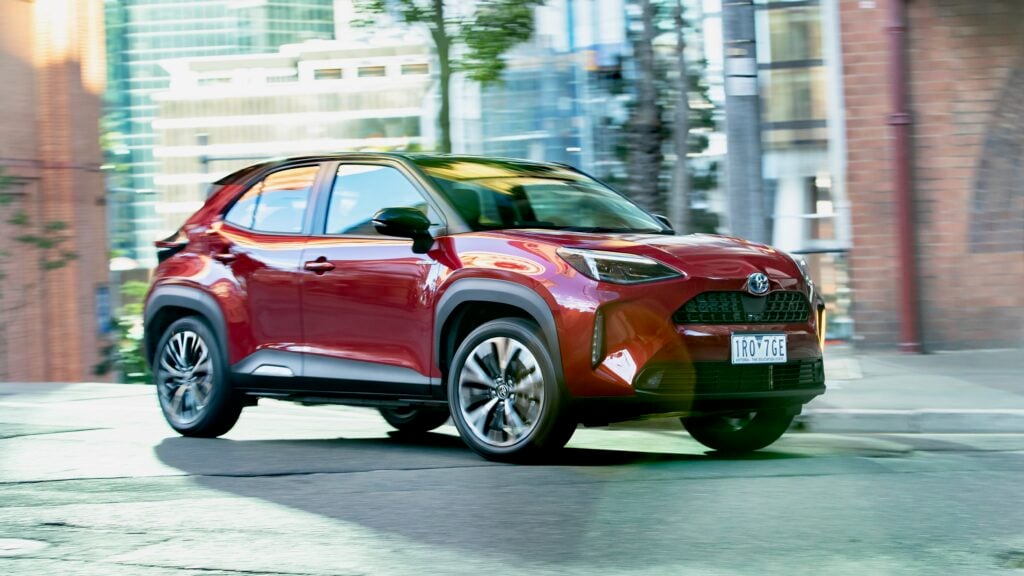
Score breakdown
Things we like
- Clever drivetrain
- Good EV range
- Long warranty
Not so much
- Bit pricey
- Ordinary ride and handling
- Noisy on the freeway
As a first go at the concept, Mitsubishi’s last-gen Outlander PHEV was far and away the best option in the line-up. It took an older platform with gasping petrol engines, added a slick electric motor setup and – instead of complicating matters – just used the engine as a generator to juice the EV drivetrain when the battery ran out.
Simple, straightforward, but innovative. Flashes of the old Mitsubishi, the one that used to produce awesome concept cars and interesting road cars.
There’s a PHEV version of the vastly improved new Outlander coming but for the moment, the sole hybrid in the Mitsubishi range is the Eclipse Cross PHEV.

The Eclipse Cross is one of the now two SUVs based on the old Lancer platform, the other being the pensionable ASX – its long-overdue replacement will surface in 2023, we’re told.
Mitsubishi intended the Eclipse Cross to be that replacement – but buyers stubbornly refused to take the bait, or, more accurately, just kept buying the ASX.
In response, Mitsubishi rejigged the Eclipse Cross, made it longer, deleted the lower bit of glass in the tailgate and took itself off to battle with the Forester, RAV4 and Chinese interloper, the MG HS.
How much is it, and what do you get?
At the top of the range, the Exceed wallops you with a $54,490 price tag –and that’s before on-road costs.
The entry-level ES is hardly cheap at $46,990 plus on-road costs, but it is reasonably well-equipped and has the important bit – the PHEV drivetrain.
Although the drivetrain itself dates back to 2013, I will concede, as did my colleague Tony O’Kane in a recent comparison with the MG HS and Kia Niro, that it was ahead of its time.

For your nearly sixty grand on-the-road you get 18-inch alloy wheels, an eight-speaker stereo, dual-zone climate control, front, side and reversing cameras, keyless entry and start, front and rear parking sensors, wireless phone charging pad, part-digital dashboard, adaptive cruise control, electric and heated front seats, sat-nav, auto LED headlights, auto wipers, head-up display and a tyre repair kit.
An 8.0-inch touchscreen runs a tired old media system but does provide Apple CarPlay and Android Auto. It also features a fairly comprehensive (if confusing set) of screens detailing the way the car is using its two energy sources and brims with largely unreadable statistics, at least until you dive into the owner’s manual.
How safe is it?
The five-star ANCAP safety rating dates back to 2017, with seven airbags, ABS and stability controls, blind-spot monitoring, forward auto emergency braking with pedestrian detection, reverse cross-traffic alert and lane departure warning.
The kids are looked after with two lots of ISOFIX points and three top-tether anchors.

Let’s move inside, how is the cabin?

It was quite useful that this car had clearly been through the press fleet wringer, with nearly 7000km under its steel-belted radials.
The interiors of press cars take an absolute pounding, with sometimes careless drivers and passengers as well as enthusiastic photographers contorting themselves into all kinds of gaps at the expense of bits of trim.
For the most part, the interior had held up well, but the piano black around the gear shifter was notably scratched.
For a car with such an advanced drivetrain, it’s not especially stylish inside, and some of the switchgear is either super-old looking (heated seat switches) or chintzy (volume control).

Being based on the smaller ASX, interior space is much as you’d expect. One of the ASX’s redeeming features is its legroom and it is basically identical here in the Eclipse Cross, which is to say there’s a fair bit of it. There isn’t much support in the back seat’s cushion though, which is a bit of a shame, because the front seats are quite good.
Front seat passengers have two cup holders and bottle holders in the doors, with the same for the rear seat dwellers. The front features a handy-sized centre console bin and, under the climate controls, there is room for a phone.
Boot space is predictably smaller than the petrol-only Eclipse Cross, with a starting bid of 359 litres when the rear seats are in place and just 626 litres with them folded out of the way.
The reality is that both are probably higher than that as these figures feel conservative. Bottom line is, there’s a fair amount of space in the Eclipse Cross’s bulky body.
| Eclipse Cross PHEV | Toyota C-HR | Mazda CX-30 | |
|---|---|---|---|
| Rear seats up | 359L | 318L | 317L |
| Rear seats down | 626L | No official figure | 430L |
What is it like to drive?

The Eclipse Cross PHEV shares a number of irritating quirks with its ICE counterpart, like the weird driving position and the mystifying inability of Mitsubishi’s chassis engineers to use the multi-link rear suspension to good effect.
Steering feel is vague and free of any information from the road surface. The artificial weighting as you turn the wheel also isn’t especially helpful, although that’s less of an issue around town.
It really does feel its age underneath the strikingly designed body. In contrast, the new Outlander shows that Mitsubishi can do so much better.

The style-focused rising rear window line does compromise your vision when you’re doing a head check, so blind-spot monitoring is certainly a handy inclusion. And the ride around town just isn’t as settled as I’d like it to be given what else is available in the class. I’ll get to the freeway in a minute.
Of course, the really important bit about this car is the PHEV drivetrain. Unlike, say, the RAV4 hybrid (not a plug-in) or the MG HS PHEV, the Eclipse Cross has a very simple system. Two electric motors – one for the front, one for the rear – drive all four wheels.
A 13.8kWh battery provides a claimed electric-only range of 55km and hot damn did I get close to that, with 52km on the trip before the engine stepped in to serve up the electrons via exploding hydrocarbons.
So it’s basically a 2.4-litre generator with 94kW at 4500rpm, and that’s just fine. It’s relatively simple and effective.
What’s great about this drivetrain is that it loves to operate in EV mode

The front motor delivers 60kW and 137Nm while the rears serve up 70kW and 195Nm, for 130kW and 332Nm totals; quite respectable, really. It’s just a pity the car weighs a hefty 1890kg.
What’s great about this drivetrain is that it loves to operate in EV mode. Even when requesting brisk acceleration, the Eclipse Cross did not resort to extra kick from the engine, relying on the battery to do its thing. It’s really quite good and gives you that EV-on-a-budget (well…) vibe.
And you can do this day-in, day-out by charging the PHEV from a wall socket, taking just a few hours to return it to full even without a wallbox.
For most Australian city-dwellers, 50-odd kilometres of electric range is plenty for a day’s motoring and if you have solar panels it’ll cost you basically nothing to charge. If you have certified carbon-free grid power, you won’t be putting out any CO2 either.

The DC fast-charging compatibility – something a surprising number of PHEVs don’t have – also means a 25-minute charge. If you’re at a shopping centre so equipped, that should be more than enough while you’re tearing around trying to avoid getting the plague.
On top of that, vehicle-to-grid capability is built-in, so when you have all the right bits and pieces, you can power your home in the event of a blackout or it will stabilise your power in the event of a brown-out.
There are limitations, of course, but that’s mighty handy and will be so during the inevitable teething problems as we phase out coal generation over the next few decades.
How is it on fuel?
My plan for the week was to see what happens when you run through the battery and don’t have the time or opportunity to recharge.
This is where it gets interesting. From a Monday pick-up, we made it to Thursday, a combination of working from home, self-imposed people avoidance and Christmas holidays meaning we weren’t going anywhere far.
We locked it up, used another car on Friday and then set off for a drive to Katoomba from Sydney on Saturday.

Again, it turns out that the PHEV system is really clever. It doesn’t completely drain the battery, so like a series hybrid from Toyota, it’s always there with a little electric juice to get you on your way or creep along at low speed.
The engine kicked on and stayed on for the run down the M5/M4/M7 and up the Great Western Highway to Katoomba. Once there, it was on and off as we dribbled around car parks and along the main street.
Take-away lunch secured, we found a spot to eat overlooking the Megalong Valley and the battery kept the climate control going and us comfortable. I was most interested in the run down the hills and how much energy the car would recover for the battery. Weirdly, it wasn’t much.
Like the petrol versions, the PHEV has lovely alloy paddleshifters, but here they instead let you choose between five levels of regenerative braking. Even set at its maximum setting, the run down the mountains didn’t recover much energy, although it did keep the engine off or running at low revs.

On the freeway, engine droning away to hold us at 110km/h, it’s quite noisy, with lots of tyre, wind and road noise penetrating the cabin. As I always say, the M4, in particular, is pretty wretched, but others in the segment do a far better job of maintaining a quiet cabin, so that was a bit of a shame.
Speaking of being held to 110km/h, the cruise control was a little, shall we say, lax about things. The speed would often drop well below the set marker for no apparent reason. That gets on your nerves pretty quickly.
We know from experience that if you drive the Eclipse Cross PHEV as intended, with the battery charged, your fuel use can be extremely low – we’ve achieved 2.8L/100km in rigorous testing, which is impressive.
This time around, our plan was to see how it fares in those situations where you’ve forgotten, or weren’t able, to get that battery charged. The result 11.2L/100km.
After a couple more days in town, the fuel economy improved to 8.3L/100km, but still not where you’d want a hybrid to be. Best to keep that battery topped up as much as possible, then.
We know from experience that if you drive the Eclipse Cross PHEV as intended, with the battery charged, your fuel use can be extremely low – we’ve achieved 2.8L/100km in rigorous testing, which is impressive.
How long is the warranty, and what are the running costs like?

Mitsubishi offers a 10-year warranty on all its cars but you do need to read the print to understand it. It’s not fine print – nothing so sneaky here lest the ACCC wield the banhammer – but you need to know the details.
First, it applies for 150,000km, which for most people is fine. Second, and this applies to all owners, you have to service it at a Mitsubishi dealership or risk reverting to the standard warranty of five years/unlimited kilometres, which itself isn’t terrible.
Servicing is also covered by a ten-year program, which is mighty helpful and matches the warranty’s length of 10 years/150,000km. Four of these services cost $299, three cost $399 and the remainder a whopping $799.
That gives you a ten-year service bill of $4790 or $479 per year on average. That’s not super cheap for a car that is hardly the last word in luxury and technology, drivetrain aside. An ICE-only Eclipse Cross is about a thousand dollars less to service over the same period.
Would you recommend it?

For the price, I’m not sure the Exceed is the one to go for. Once you stack on the on-roads and servicing, you’re getting awfully close to the price of an unadorned Polestar 2 or, shockingly, a Tesla Model 3.
Neither are as well-equipped but if you live in the right state and are more interested in electric motivation than ultimate safety or comfort, the Eclipse Cross Exceed’s proposition is a little shaky.
Venture down the range and with less bling and a lower price tag, the PHEV starts to make sense if you’re committed to charging it regularly and only want the ICE as a backup for visiting Aunty Merle out in the bush.
Whichever Eclipse Cross PHEV you buy, though, you’re certainly getting the best one because it is better than the petrol-only version in the same way the Outlander was – and by a similar margin.
If you’re just looking at the direct competition – the MG HS PHEV – you’re getting a pretty good deal from the Mitsubishi for a few more dollars as well as the backing of a long, long warranty.
2022 Mitsubishi Eclipse Cross Exceed PHEV specifications
| Body: | 5-door mid-size SUV |
|---|---|
| Drive: | all-wheel |
| Engine: | 2.4-litre four-cylinder |
| Transmission: | single-speed reduction gear |
| Power: | 94kW @ 4500rpm (ICE) |
| Torque: | 199Nm @ 4500rpm (ICE) |
| Bore stroke (mm): | 88.0 x 97.0 |
| Compression ratio: | 12.0 : 1.0 |
| EV drivetrain | 60kW/137Nm front; 70kW/195Nm rear |
| EV range | 55km (claimed) |
| Battery capacity | 13.8kWh lithium-ion |
| 0-100km/h: | 10.9 sec (claimed) |
| Fuel consumption: | 1.9L/100km (combined) |
| Weight: | 1890kg |
| Suspension: | MacPherson struts front/multi-link rear |
| L/W/H: | 4545mm/1805mm/1685mm |
| Wheelbase: | 2670mm |
| Brakes: | 310mm ventilated disc front / 290mm solid disc rear |
| Tyres: | 255/55 R18 Bridgestone Ecopia |
| Wheels: | 18-inch alloy wheels ( spare) |
| Price: | $53,990 before on-road costs |
Score breakdown
Things we like
- Clever drivetrain
- Good EV range
- Long warranty
Not so much
- Bit pricey
- Ordinary ride and handling
- Noisy on the freeway




